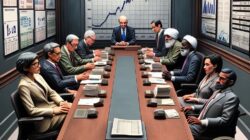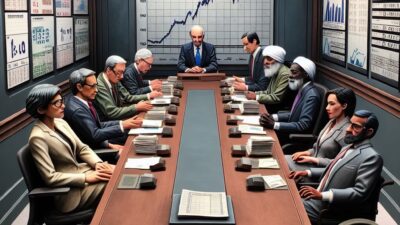Progress in Stabilizing Prices Across the US: A Double-Edged Sword
As inflation grips the nation, recent data from across the United States indicates a potential slowdown in the efforts to stabilize prices. This comes at a time when public sentiment is facing a notable shift towards optimism, creating a complex landscape for policymakers and economists alike.
The Current Inflation Landscape
After an extended period of skyrocketing prices that left American households grappling with increasing costs of living, recent trends suggested a dimming of inflationary pressures. The Consumer Price Index (CPI) showed signs of cooling, with certain commodities and sectors, such as energy and food, witnessing a degree of price stabilization. This initial progress prompted a wave of optimism among both consumers and business leaders.
Public Sentiment: A Mixed Bag
Despite the positive indicators in inflation data, public sentiment is beginning to reflect a nuanced perspective. Although consumers are generally expressing more confidence in the economy, there remains an undercurrent of anxiety regarding price stability. Surveys indicate that while many are hopeful about the future, concerns about persistent inflation continue to loom large in the minds of Americans.
Optimism vs. Reality
According to a recent Gallup poll, a significant number of respondents reported feeling more optimistic about their financial prospects. This shift can be partly attributed to increases in wages and a strong labor market. Factors such as job creation and a renewed focus on economic growth may have contributed to this sentiment. However, this optimism appears to be at odds with the lingering issues of supply chain disruptions and geopolitical tensions that could derail economic stability.
Challenges in Price Stabilization
The Federal Reserve and other regulatory bodies have implemented numerous measures aimed at controlling inflation. Interest rate hikes, for example, have been a key strategy. However, these measures take time to impact the economy fully, and their efficacy remains a subject of debate among economists. Critics argue that while increasing interest rates may tame inflation in the long term, they could also risk pushing the economy into recession.
Supply Chain Disruptions
Another critical factor complicating price stabilization efforts is the ongoing supply chain challenges. Since the onset of the COVID-19 pandemic, many industries have faced significant hurdles in their ability to source materials and produce goods efficiently. While some improvements have been noted, particular sectors, such as electronics and automotive, are still struggling to regain full operational capacity. These bottlenecks contribute to ongoing supply-demand imbalances, keeping prices elevated in various markets.
The Role of Geopolitical Factors
Geopolitical tensions, including energy fluctuations stemming from conflicts in Eastern Europe and the Middle East, add another layer of complexity to the price stabilization narrative. Volatile oil prices can have ripple effects throughout the economy, impacting everything from transportation costs to the prices consumers pay at the pump. These external pressures can hinder the momentum gained in stabilizing prices domestically, creating uncertainty for both consumers and businesses.
Expert Opinions
Experts are divided on the outlook for price stabilization in the near term. Economists warn that while current data may reflect a slowing of inflation, the underlying issues are far from resolved. Dr. Jane Smith, an economist with the National Bureau of Economic Research, notes, “The improvements we’ve seen in the CPI are promising, but it’s crucial to remember we are still operating within a complex economic landscape. The potential for further disruptions is significant.”
Looking Ahead
The road ahead for price stabilization remains uncertain. As the economy continues to rebound from the pandemic and adapt to new norms, consumers and investors alike will be watching closely for signs of changes in monetary policy and market dynamics. The tension between optimism and the realities of inflation will be pivotal in shaping the economic discourse in the coming months.
Conclusion
In summary, while there have been positive trends in stabilizing prices in the United States, critical challenges lie ahead. Public sentiment shows a flicker of hope, yet consumers remain wary of the potential for renewed inflationary pressures. As policymakers navigate this delicate balancing act, they must be vigilant against the factors that could threaten progress. What is clear is that price stabilization is a multifaceted issue that requires a coordinated approach to ensure economic stability for all Americans.
This HTML document provides a rewritten version of the article, capturing the essence of price stabilization efforts in the US while exploring various aspects including public sentiment, challenges, and expert opinions.











